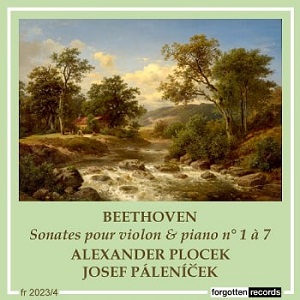
Ludwig van Beethoven (1770-1827)
Violin Sonata No 1 in D, Op 12 No 1 (1797-98)
Violin Sonata No 2 in A, Op 12 No 2 (1797-98)
Violin Sonata No 3 in E-flat, Op 12 No 3 (1797-98)
Violin Sonata No 4 in A minor, Op 23 (1800)
Violin Sonata No 5 in F, Op 24 ‘Spring’ (1800-01)
Violin Sonata No 6 in A, Op 30 No 1 (1801-02)
Violin Sonata No 7 in C minor, Op 30 No 2 (1801-02)
Alexander Plocek (violin)
Josef Páleníček (piano)
rec. 1952-60, Domovina Studio, Prague
Forgotten Records FR2023-24 [CDs: 73 + 72]

Violin Sonata No 8 in G, Op 30 No 3 (1801-02)
Violin Sonata No 9 in A, Op 47 ‘Kreutzer’ (1802-03)
Violin Sonata No 10 in G, Op 96 (1812)
Alexander Plocek (violin)
Josef Páleníček (piano)
rec. 1952-60, Domovina Studio, Prague
Forgotten Records FR2025 [78]
In a review of the cycle of Beethoven violin sonatas made by Jean Fournier and Ginette Doyen between 1952-54 (review), I idly wondered if the company would release the cycle made by Alexander Plocek and Josef Páleníček, which I mistakenly thought omitted sonatas 1 and 6. Well, here it is in a similar format to that Fournier/Doyen cycle; a twofer and a single. Forgotten Records doesn’t seem to release three CD sets as such, though this is effectively what this is, albeit available separately.
It was recorded between 1952 and 1960 by Supraphon in the Domovina Studios in Prague and featured two of Czechoslovakia’s leading instrumentalists. Plocek (1914-82) was a one-time member of the Černy String Quartet and almost all his surviving recordings are of chamber music, though he did record Suk’s Fantasy with Ančerl and the Beethoven Romances with Šejna. His chamber partners were Páleníček and in the trio repertoire, cellist Miloš Sádlo, and later Saša Večtomov.
Both men form a sympathetic ensemble, as one would expect, and the fact that this cycle took eight years to complete seems to have given them the opportunity to grow into repertoire that they, in any case, presumably knew very well. That said, now that I’ve heard the cycle, I’m slightly disappointed by elements of it. In the First Sonata Plocek sounds fractionally under the note early on and though he soon plays himself in, his tone is inclined to be a touch thin, at least as recorded. However, in compensation, accompanying figures here and throughout are deft, finely scaled, dynamics are thoughtfully employed and appropriately supportive. The Rondo finale of No 1 is charmingly executed. The Andante of No 2 is rather small-scaled but retains an intimacy that appeals. His technique is naturally fine, and he characterises adeptly; the central movement of No 4 is quietly witty. Wit is a quality not missing in the cycle though it’s not the kind that comes out to grab you; it’s more interior and, indeed, on occasion, deadpan, as in the end of the opening movement of No 2.
The least impressively recorded sonatas are inevitably the monos of 1952 – Nos 5, 7 and 9; that’s to say two of the most popular in the ‘Spring’ and ‘Kreutzer’. The ‘Spring’ is rather distantly recorded and Páleníček makes a very uncharacteristic finger slip early on. Why wasn’t this covered or retaken? The recording also grafts a rather metallic sheen to Plocek’s tone. The violinist was a notably clean player and had few idiosyncrasies which made him an admirable teacher, but which also meant he was less individualistic as a soloist. Nevertheless, he was more than capable of meeting the demands of No 6 and in particular the pathos of its slow movement. No 7 is full of urgency but again the recording is rather dim and Páleníček can sound clangy in fortes – courtesy of the engineering, no doubt.
No 8 was taped in 1960 and is athletic, lightly bowed with a suave finely characterised finale. Theirs is a deft and musical musicianship. The Kreutzer is notable for Plocek’s refinement and for Páleníček’s rapport, for the violinist’s tight trills, and for both men’s sinuous exploration of the variations You can hear a rare example of Plocek’s expressive slide in the opening movement of No 10 (he employs it again in the repeat) in what is an elegant, thoughtful reading that doesn’t plumb too many depths.
This set has been well transferred here, though as usual, there are no notes, just a couple of internet links for the pianist. Nothing for the violinist. You can also download the whole set via Supraphonline.
Taken overall, this is an accomplished set with much fine playing. It’s not, however, to my disappointment, quite as good as I had hoped. The recording is sometimes unhelpful and Plocek’s tonal qualities don’t always come across.
Jonathan Woolf
 |
Sonatas 1-7 ~ | Sonatas 8-10 |


















